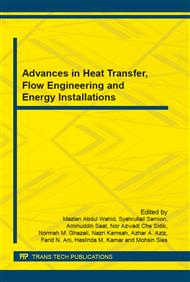[1]
S. Kahn Ribeiro, S. Kobayashi, M. Beuthe, J. Gasca, D. Greene, D.S. Lee, Y. Muromachi, P.J. Newton, S. Plotkin, D. Sperling, R. Wit, P.J. Zhou, Transport and its infrastructure. In Climate Change 2007: Mitigation. Contribution of Working Group III to the Fourth Assessment Report of the Intergovernmental Panel on Climate Change [B. Metz, O.R. Davidson, P.R. Bosch, R. Dave, L.A. Meyer (eds)]. Cambridge University Press, Cambridge, United Kingdom and New York, NY, USA (2007).
DOI: 10.1080/01944363.2014.954464
Google Scholar
[2]
J.R. Sand, S.K. Fischer, Total Environmental Warming Impact (TEWI) Calculations for Alternative Automotive Air-Conditioning Systems, 1997 SAE International Congress, Detroit, Michigan (1997).
DOI: 10.4271/970526
Google Scholar
[3]
S.K. Fischer, Comparison of Global Warming Impacts of Automobile Air-Conditioning Concepts. 1995 International CFC and Halons Alternative Conference, Washington, D. C (1995).
Google Scholar
[4]
M. Konz, A Generic Simulation of Energy Consumption of Automobile Air Conditioning Systems. M Tech Eng Thesis. Nelson Mandela Metropolitan University, (2007).
Google Scholar
[5]
H. Zhang, L. Dai, G. Xu, Y. Li, W. Chen, and W. Tao, Studies of air-flow and temperature fields inside a passenger compartment for improving thermal comfort and energy saving. Part 1: Test/numerical model and validation, Applied Thermal Engineering, 29 (2009).
DOI: 10.1016/j.applthermaleng.2008.10.005
Google Scholar
[6]
S. Kaushik, K.H. Chen, T. Han and B. Khalighi, Micro-cooling/heating strategy for energy efficient HVAC system, SAE Technical Paper (2011).
DOI: 10.4271/2011-01-0644
Google Scholar
[7]
M.A. Roscher, W. Leidholdt and J. Trepte, High Efficiency Energy Management in BEV Applications. Electrical Power and Energy Systems, 37(2012) 126-130.
DOI: 10.1016/j.ijepes.2011.10.022
Google Scholar
[8]
C. Kwon, C. Lee, L. Foster and J. Kwon, Development of an Energy-Saving Occupied-Zone HVAC System (OZ HVAC). SAE Technical Paper (2012).
DOI: 10.4271/2012-01-0320
Google Scholar
[9]
R. Farrington and J. Rugh, Impact of Vehicle Air-Conditioning on Fuel Economy, Tailpip Emissions, and Electric Vehicle Range, Earth Technologies Forum Washington, D.C. (2000).
Google Scholar
[10]
J. Chen, Y. Zhao and Z. Qi, New developments in mobile air conditioning systems in China. Front. Energy 2011, 5(1) (2011) 53–58.
DOI: 10.1007/s11708-010-0137-3
Google Scholar
[11]
F. Stancato, H. Onusic, R.A. Antonelli and P.U. Avila, Experimental and Numerical Analysis of Cooling Loads in a Road Bus, SAE Technical Paper (1992).
DOI: 10.4271/921474
Google Scholar
[12]
F. Stancato and H. Onusic, Road Bus Heat Loads Numerical and Experimental Evaluation, SAE Technical Paper (1997).
DOI: 10.4271/971825
Google Scholar
[13]
D. Huang, M. Wallis, E. Oker, and S. Lepper, Design of Vehicle Air Conditioning Systems Using Heat Load Analysis, SAE Technical Paper (2007).
DOI: 10.4271/2007-01-1196
Google Scholar
[14]
K. Mohamed Mansor, Developing of Bus Air-Conditioning System that Responds to a Variation in Cooling Load, Ph.D. Thesis, Universiti Teknologi Malaysia, (2007).
Google Scholar
[15]
Y. Zheng, B. Mark, and H. Youmans, A Simple Method to Calculate Vehicle Heat Load, SAE Technical Paper (2011).
DOI: 10.4271/2011-01-0127
Google Scholar
[16]
M.F. Sukri, K. Sumeru, H. Nasution, M.Y. Senawi and M.N. Musa: In Press, Simulation of Vehicle Cooling Loads at Different Orientations, Heat Transfer Research (2014).
DOI: 10.1615/heattransres.2016007723
Google Scholar
[17]
H. Mohamed Kamar, Computerised Simulation of Automotive Air Conditioning System. Ph.D. Thesis, Universiti Teknologi Malaysia, (2008).
Google Scholar
[18]
M.A. Fayazbakhsh and M. Bahrami, Comprehensive Modeling of Vehicle Air Conditioning Loads Using Heat Balance Method, SAE Technical Paper (2013).
DOI: 10.4271/2013-01-1507
Google Scholar
[19]
C.P. Arora, Refrigeration and Air Conditioning, third ed., McGraw Hill. Singapore, (2009).
Google Scholar
[20]
ASHRAE, ASHRAE Handbook of Fundamentals, ASRHAE, Inc., Atlanta, GA, (2009).
Google Scholar
[21]
ASHRAE, ASHRAE Handbook of Fundamentals, ASRHAE, Inc., Atlanta, GA, (2005).
Google Scholar
[22]
K. Shahril, M.K. Nurhayati, M. Sabri, Heat transfer simulation of motorcycle fins under varying velocity using CFD method, 2nd International Conference on Mechanical Engineering Research (2013).
DOI: 10.1088/1757-899x/50/1/012043
Google Scholar
[23]
ASHRAE, ASHRAE Handbook of Fundamentals. ASRHAE, Inc. Atlanta, GA, (1993).
Google Scholar
[24]
ASHRAE, ASHRAE Handbook of Fundamentals. ASHRAE, Inc. Atlanta, GA, (1985).
Google Scholar
[25]
ASHRAE, ASHRAE Handbook of Systems and Equipment. ASRHAE, Inc. Atlanta, GA, (2000).
Google Scholar
[26]
M.Y. Senawi, Development of a Building Energy Analysis Package (BEAP) and Its Application to the Analysis of Cool Thermal Energy Storage System. Ph.D. Thesis, Universiti Teknologi Malaysia, (1998).
Google Scholar


